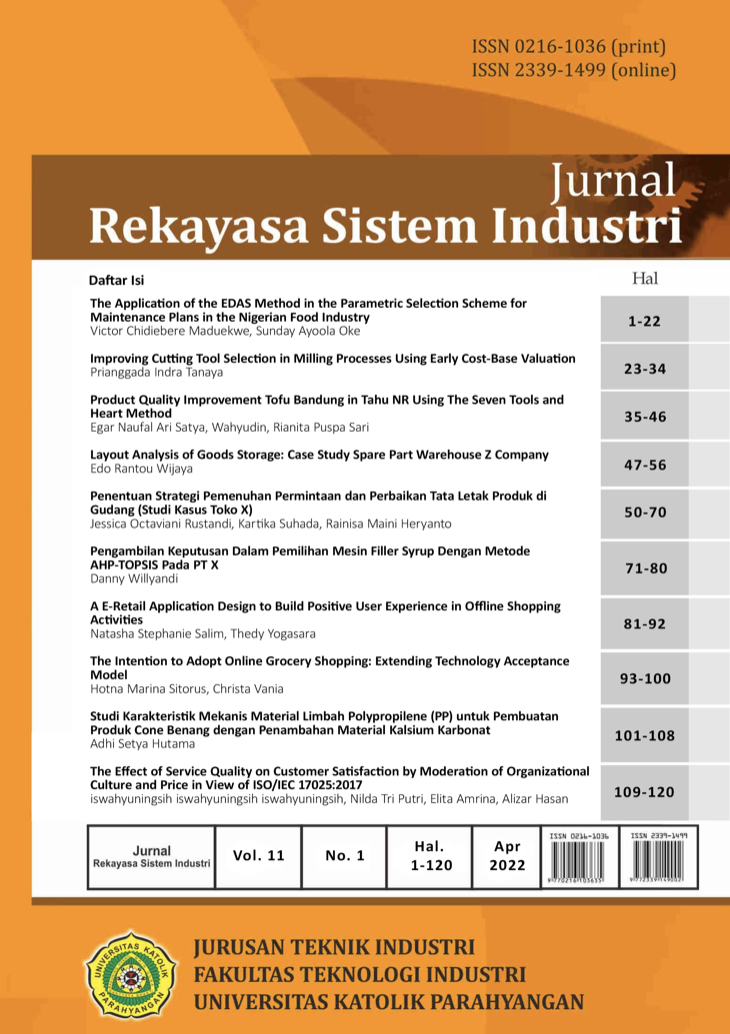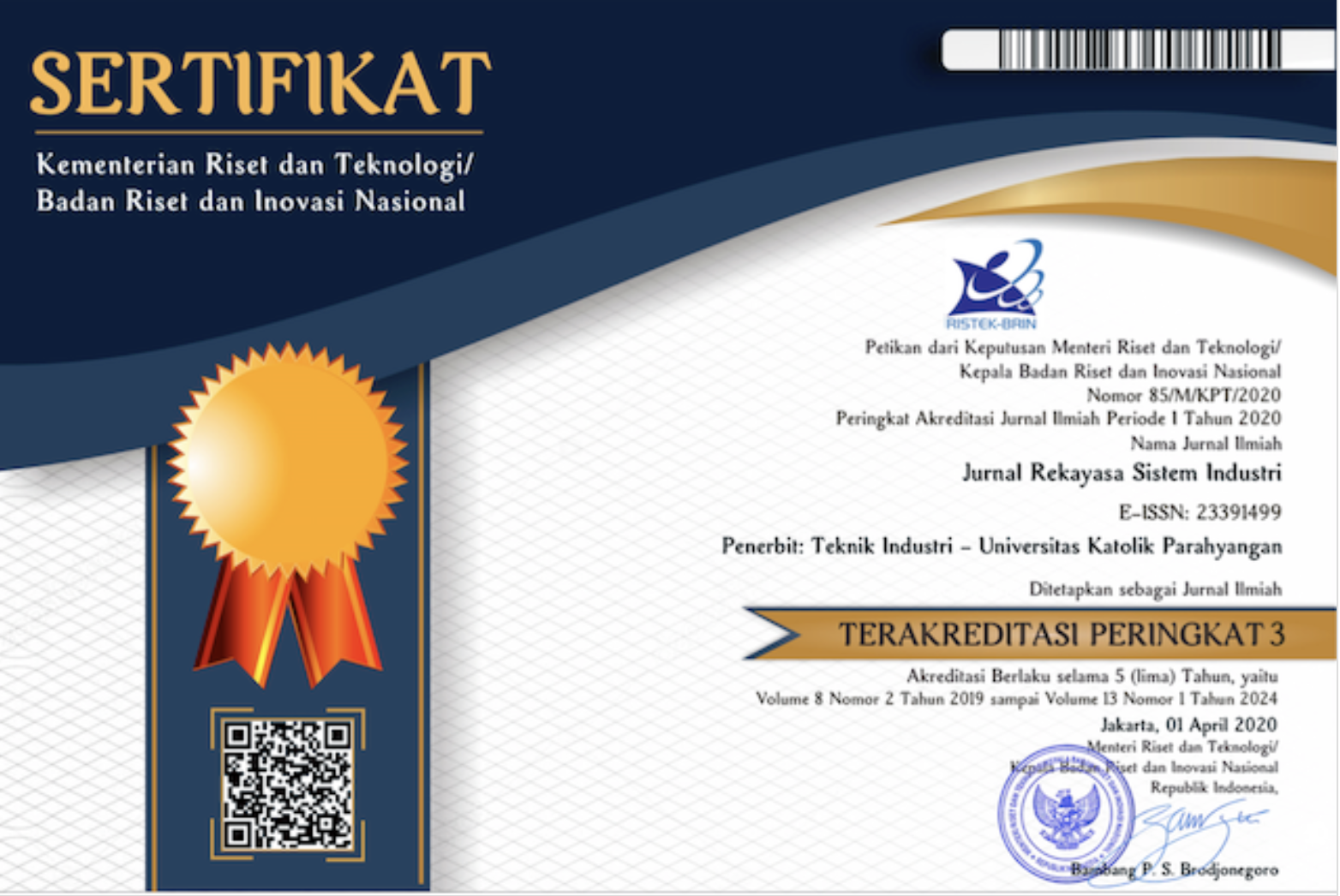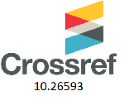NIAT ADOPSI TEKNOLOGI ONLINE GROCERY SHOPPING: EKSTENSI TECHNOLOGY ACCEPTANCE MODEL
DOI:
https://doi.org/10.26593/jrsi.v11i1.5204.93-100Kata Kunci:
adopsi teknologi, kompatibilitas, pengaruh sosial, risiko, TAMAbstrak
Penelitian ini bertujuan untuk mengkaji faktor yang memengaruhi niat konsumen dalam mengadopsi layanan Online Grocery Shopping (OGS). OGS adalah layanan yang disediakan oleh toserba yang memungkinkan konsumen berbelanja kebutuhan sehari-hari secara daring melalui situs web. Meski layanan OGS menjanjikan banyak manfaat, tingkat penggunaannya masih belum memuaskan. Pengembangan model penelitian dilakukan dengan mengaplikasikan Technology Acceptance Model (TAM) yang diekstensi dengan kompatibilitas, visibilitas, pengaruh sosial, dan risiko. Model penelitian diuji pada konsumen sebuah toserba yang telah memiliki layanan OGS namun kesulitan mencapai target jumlah penggunanya. Pengumpulan data dilakukan dengan metode survei menggunakan kuesioner daring. 108 data digunakan untuk menguji model pengukuran dan model struktural berdasarkan metode PLS-SEM. Penelitian ini menemukan bahwa niat adopsi layanan OGS secara signifikan dipengaruhi oleh persepsi kemanfaatan dan persepsi kemudahan pakai. Berdasarkan analisis pengaruh total ditemukan bahwa niat adopsi dipengaruhi oleh kompatibilitas, persepsi kemanfaatan, persepsi kemudahan pakai, pengaruh sosial dan persepsi risiko. Penelitian ini juga merumuskan sejumlah rekomendasi bagi pengelola toserba untuk dapat meningkatkan jumlah konsumen yang mau menggunakan layanan OGS.
Referensi
Chaouali, W., Yahia, I. B., & Souiden, N. (2016). The interplay of counter-conformity motivation, social influence, and trust in customers' intention to adopt Internet banking services: The case of an emerging country. Journal of Retailing and Consumer Services, 28, 209-218.
Chien, A. W., Kurnia, S. & von Westarp, F. (2003). The Acceptance of Online Grocery Shopping. Proceedings of 16th Bled Electronic Commerce Conference, Bled, Slovenia, 219-233.
Cho, E., & Son, J. (2019). The effect of social connectedness on consumer adoption of social commerce in apparel shopping. Fashion and Textiles, 6(1). https://doi.org/10.1186/s40691-019-0171-7
Davis, F.D. (1989). Perceived Usefulness, Perceived Ease of Use, and User Acceptance of Information Technology. MIS Quarterly, 13(3), 319-340.
Driediger, F. & Bhatiasevi, V. (2019). Online grocery shopping in Thailand: Consumer acceptance and usage behavior, Journal of Retailing and Consumer Services, 48, 224-237.
Giovanis, A.N., Binioris, S., & Polychronopoulos, G. (2012). An extension of TAM model with IDT and security/privacy risk in the adoption of internet banking services in Greece. EuroMed Journal of Business, 7(1), 24-53.
Ha, S., & Stoel, L. (2009). Consumer e-shopping acceptance: Antecedents in a technology acceptance model. Journal of Business Research, 62(5), 565-571.
Hair, J.F., Hult, G.T.M., Ringle, C.M., & Sarstedt, M. (2014). A Primer on Partial Least Squares Structural Equation Modeling (PLS-SEM). Singapore: Sage Publications.
Li, Y. H., & Huang, J. W. (2009). Applying theory of perceived risk and technology acceptance model in the online shopping channel. World Academy of Science, Engineering and Technology, 53(1), 919-925.
Miller, J., & Khera, O. (2010). Digital library adoption and the technology acceptance model: A cross‐country analysis. The Electronic Journal of Information Systems in Developing Countries, 40(1), 1-19.
Moore, G. C., & Benbasat, I. (1991). Development of an instrument to measure the perceptions of adopting an information technology innovation. Information Systems Research, 2(3), 192-222.
Rogers, E. M. (2003). Diffusion of Innovations, New York: The Free Press.
Saadé, R., & Bahli, B. (2005). The impact of cognitive absorption on perceived usefulness and perceived ease of use in on-line learning: an extension of the technology acceptance model. Information & Management, 42(2), 317-327.
Sitorus, H.M., Govindaraju, R., Wiratmadja, I.I., & Sudirman, I. (2016). Technology adoption: an interaction perspective. IOP Conference Series: Materials Science and Engineering, 114, 1-7.
Sitorus, H.M., Govindaraju, R., Wiratmadja, I.I., & Sudirman, I. (2019). Examining the Role of Usability, Compatibility and Social Influence in Mobile Banking Adoption in Indonesia. International Journal of Technology, 10(2), 351-362.
Venkatesh, V., & Davis, F. D. (2000). A theoretical extension of the technology acceptance model: Four longitudinal field studies. Management Science, 46(2), 186-204.
Venkatesh, V., Morris, M. G., Davis, G. B., & Davis, F. D. (2003). User acceptance of information technology: Toward a unified view. MIS Quarterly, 27(3), 425-478.
Verhoef, P. C., & Langerak, F. (2001). Possible determinants of consumers’ adoption of electronic grocery shopping in the Netherlands. Journal of Retailing and Consumer Services, 8(5), 275-285.
Wu, J. H., & Wang, S. C. (2005). What drives mobile Commerce?: An empirical evaluation of the revised technology acceptance model. Information & management, 42(5), 719-729.













